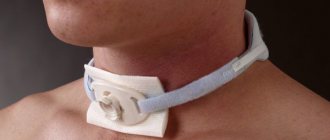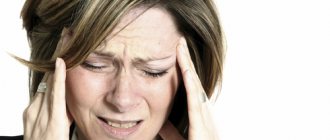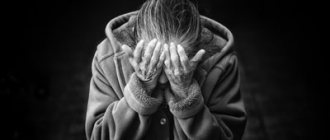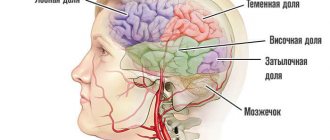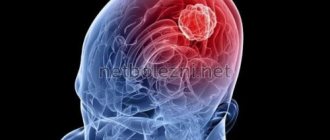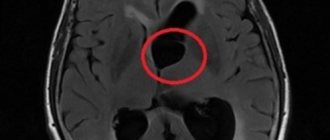Symptoms of a concussion in a child: information for parents
The most common diagnosis in pediatric traumatology is concussion.
This diagnosis refers to a mild degree of traumatic brain injury, but the consequences of a concussion in children can be the most unpredictable. Emotional lability, a tendency to convulsive manifestations, weakened memory, headaches, increased susceptibility to infectious and viral diseases - this is an incomplete list of possible consequences after a concussion. The main causes of concussion are different for each age group. For example, if for infants such factors are careless care and a careless attitude on the part of parents, then for children 3-6 years old, increased motor activity and imperfect coordination come to the fore. For schoolchildren, the reasons are very varied.
Please note that a mild concussion in an infant can occur even with severe motion sickness.
And one more thing: with this brain damage, no irreversible damage is observed.
How to treat a child
Treatment of concussion in children is carried out in a hospital setting. First aid for suspected illness is to provide mental and physical comfort to the child. You cannot shout or insult children; it is advisable to put them in a horizontal position. Call emergency services immediately. Before doctors arrive, it is prohibited to give medications, as this will distort the clinical picture of the disease. If there is a wound on the head, you can apply a sterile bandage to it yourself.
In the hospital, medications are used that improve brain metabolism. In the first 5 days, strict bed rest is required, which then expands. Antiemetics are used as medications, for example, cerucal, motilium, as well as nootropics and vitamins. The most commonly used nootropic drugs are:
- piracetam;
- gliatilin;
- cytoflavin;
- pantogam;
- glycine.
Treatment is carried out under the dynamic supervision of staff. The prognosis of therapy is favorable.
Signs of a concussion in children
The main signs of a concussion are loss of consciousness for a short period of time, poor spatial orientation, headache, dizziness and weakness. In some cases, vision may deteriorate. Symptoms of a concussion in a child also depend on age.
Clinical manifestations of this condition in infants are as follows:
- frequent regurgitation (possible single vomiting);
- pale face;
- decreased appetite and refusal to eat;
- swelling of the fontanelle;
- poor sleep, moodiness, crying for no reason.
Signs of a concussion in children from three to six years of age: possible short-term loss of consciousness, nausea and vomiting (one-time), dizziness, bradycardia, pale skin, sweating. The child can show where it hurts and what exactly happened.
How does a concussion manifest in schoolchildren?
- obvious loss of consciousness (10 to 15 minutes);
- Strong headache;
- severe lack of coordination;
- constant nausea and vomiting;
- presence of neurological symptoms;
- The temperature during a concussion in children remains normal.
Please note that a characteristic feature of concussion in childhood is an increase in symptoms. If immediately after the injury the child’s condition can be described as quite satisfactory, then over time it noticeably worsens.
If you have a head injury, consult a specialist! Timely diagnosis and treatment will help avoid many complications and serious consequences. On our website you will find a list of doctors and diagnostic measures that a child may need after a concussion.
What is traumatic brain injury
Traumatic brain injury (TBI) is mechanical damage to the skull and intracranial structures (brain, blood vessels, nerves, meninges).
Manifestations of traumatic brain injury in children differ significantly from symptoms characteristic of adults, and they are due to the characteristics of the child’s body, namely:
- the process of ossification of the baby’s skull is not yet complete, the bones of the skull are plastic, flexible, their connection with each other is loose;
- the brain tissue is immature, saturated with water, differentiation of the structures of the nerve centers and the cerebral circulatory system is not complete. Thus, on the one hand, brain tissue has greater compensatory capabilities and a so-called safety margin (soft bones of the skull and a larger amount of fluid in the brain than in adults can absorb shock). On the other hand, since it is the immature brain tissue that is exposed to trauma, which can lead to disruption of the development of its structures and provoke further limitation of mental development, emotional disturbances, etc.
Diagnostics
After the examination, the doctor may prescribe additional tests, namely: x-rays, MRI, neurosonography, computed tomography or electroencephalography.
X-rays help reveal the integrity of the skull bones.
Neurosonography is prescribed for children under 2 years of age. Using this procedure, the doctor will be able to identify this or that brain pathology.
Electroencephalography will allow you to study the bioelectrical activity of the brain and assess the severity of the injury.
Computed tomography is an effective method for detecting brain damage.
Treatment
Severe injuries (skull fractures, brain contusions, soft tissue injuries) will be excluded with proper examination and diagnosis. MRI and head x-rays can help diagnose internal brain damage. A neurologist examines the symptoms and makes a final conclusion.
You can treat your child at home after doctors have ruled out all possible complications. When treating at home, parents should ensure that the child maintains bed rest. The duration of bed rest directly depends on the symptoms. Doctors recommend keeping your child in bed for a while even after visible symptoms disappear. On average, complete recovery takes from 3 days to two weeks; in some cases, treatment can be longer.
Incorrect treatment can lead to serious complications in the future, so do not forget to constantly consult with your doctor during the treatment process and tell him about any changes in your baby’s condition.
Methods for diagnosing TBI
An important examination for head trauma in infants is neurosonography - a study of the structure of the brain using an ultrasound machine through the child’s large fontanel (such a study is possible until the large fontanelle closes, up to 1 - 1.5 years). This method is easy to use, does not have a negative effect on the body, and provides enough information to determine treatment tactics for the patient. With its help, you can first of all exclude or determine the presence of intracranial hemorrhages (the most life-threatening). The only limitation to its use may be the absence in the hospital of an ultrasound machine or a specialist who knows how to operate it (for example, not all hospitals in the country that have ultrasound machines can conduct emergency neurosonography at night, since the specialist works during the day).
If intracranial hemorrhage is suspected (especially if for various reasons it is not possible to do neurosonography), a lumbar puncture is performed - a therapeutic and diagnostic procedure in which a hollow needle connected to a syringe is used to puncture the area of the second to fourth lumbar vertebrae of one of the spaces of the spinal cord (subarachnoid space) and taking a portion of cerebrospinal fluid for examination under a microscope. The presence of intracranial hemorrhage is determined by the presence of blood cells in the cerebrospinal fluid.
In addition, there are more complex methods for examining a child’s head: computed tomography (CT) and magnetic resonance imaging (MRI).
Computed tomography (CT) (from the Greek tomos - segment, layer + Greek grapho - to write, depict) is a research method in which images of a certain layer (slice) of the human body (for example, the head) are obtained using X-rays. With CT, the rays hit a special device that transmits information to a computer, which processes the received data on the absorption of X-rays by the human body and displays the image on the monitor screen. In this way, the smallest changes in the absorption of rays are recorded, which in turn allows you to see what is not visible on a regular x-ray. It should be noted that radiation exposure with CT is significantly lower than with conventional X-ray examination.
Magnetic resonance imaging (MRI) is a diagnostic method (not associated with x-rays) that allows you to obtain layer-by-layer images of organs in various planes and construct a three-dimensional reconstruction of the area under study. It is based on the ability of some atomic nuclei, when placed in a magnetic field, to absorb energy in the radio frequency range and emit it after the cessation of exposure to the radio frequency pulse. For MRI, various pulse sequences have been developed to image the structures under study to obtain optimal contrast between normal and altered tissues. This is one of the most informative and harmless diagnostic methods.
But the widespread use of CT and MRI in early childhood is difficult due to the need to conduct this examination in children in a state of immobility (under anesthesia), since an important condition for the successful implementation of the technique is the immobility of the patient, which cannot be achieved from an infant.
Shaken baby syndrome
Everyone knows that mothers simply need rest (just like other people who regularly care for a small child). Today we will raise the topic of what can happen if a mother does not rest for a long time and, as a result, burns out.
Babies cry a lot in the first year of life. Sometimes mothers cannot stand it and, in response to prolonged crying, begin to do things that they could not even think of before: they shake the child violently or throw him against something.
After this, 2 scenarios may follow:
1. The baby will be lucky - he will get away with only a minor fright, a couple of bruises and abrasions.
2. The baby will be unlucky - the baby will develop shaken baby syndrome, which poses a threat to his health and life.
What is shaken baby syndrome?
A small child has weak neck muscles, and if the baby is shaken, his head begins to hang freely, and its contents begin to bang against the skull. This causes multiple damage to brain tissue and supply vessels.
Note that the consequences from shaking are much more serious than from a blow when a child falls from a small height.
Of course, shaken baby syndrome can also develop with increased swinging, throwing up and other situations in everyday life. However, this is much less common than what is defined as child abuse.
What's next?
The child has difficulty breathing, convulsions, lethargy and drowsiness. When parents contact a medical institution, the correct diagnosis is made, at best, within a day.
Late diagnosis is usually associated with the following reasons:
1. The parents did not even understand that the symptoms that arose in the child could be the result of shaking, so they kept silent about this fact.
2. The parents realized that the child was experiencing symptoms due to shaking and, fearing the consequences, kept silent about this fact.
Without truthful evidence, it is quite difficult to diagnose pathology, because with a concussion there are usually no external injuries. But it is at this stage that lost time can cause death.
The baby is usually brought to the hospital with nonspecific symptoms: difficulty breathing, drowsiness, vomiting, convulsions, loss of consciousness. In this case, the fact of injury is denied, and there are no external injuries.
Much later, it turns out that the symptoms appeared immediately after shaking (in more than 90% of cases) and this was not the first time the child was shaken (in 70% of cases).
What diagnostics are needed?
The following methods are used to diagnose shaken baby syndrome:
1. Neuroimaging methods (MRI or CT) are necessary to identify hemorrhages and areas of ischemia.
2. CSF analysis - used to confirm the presence of hemorrhage and rule out meningitis (due to the similarity of symptoms).
3. General and biochemical blood test.
4. Ultrasound and radiography – necessary if additional damage is suspected.
The most important and at the same time difficult task for a doctor is to prove that brain damage is associated with an act of abuse, and not just with an injury resulting from a fall (for example, when a baby is just learning to walk and often gets hit).
And it is impossible to determine what is worse - not recognizing an adult who harms a child or blaming an innocent person, thereby destroying a family.
How to help a child?
Shaken baby syndrome is often accompanied by retinal hemorrhage, as well as other manifestations of domestic violence - fractures, hematomas, damage to internal organs, etc.
A child who has suffered a concussion should be treated in intensive care. Doctors need to try to preserve as much brain tissue as possible in the first minutes (by removing the accumulation of blood, sometimes surgically, to eliminate breathing and circulatory disorders). Let us note that about 39% of children require emergency resuscitation upon arrival at a medical facility.
Unfortunately, medical care cannot always help avoid tragedy:
- about 23% of children with shaken baby syndrome die;
- up to 55% of children remain with neurological pathologies;
- up to 65% subsequently suffer from visual impairment.
Thus, the best option is not to let it get to this point and try to find enough time for proper rest.

